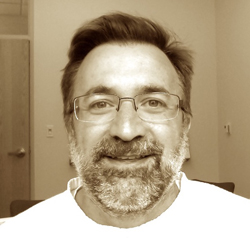4 December 2023–As The Seismic Record nears its three-year anniversary, we asked Editor-in-Chief Keith Koper to talk about how the journal has evolved and what to expect next in its pages.
SSA: The Seismic Record will celebrate its three-year anniversary in 2024. Why do you think the journal has been successful so far?
KK: SSA has been around since 1906, and this is only its third journal. The whole weight of our society is behind TSR, and it has the same care and will soon have the same stature as its sister journals BSSA and SRL. SSA is the premier scientific society for earthquake science in the world, and so TSR has that reputation and that brand behind it.
We’ve seen that with the submissions we’ve had so far. I’ve been impressed by how quickly we’ve had “buy-in” from such a broad section of the community, not just early career but senior scientists, and a diverse response from outside the United States. And from our authors, we hear good things about the experience, the service, the rigor. We get a lot of emails from our authors saying they will submit papers again.
SSA: What are some good reasons to publish in TSR?
KK: The first is the speed of our process. We have rigorous, swift peer review, because we’ve got a really good group of associate editors who have a wide range of contacts they ask to be reviewers, so our speed to first decision is under a month in most cases.
 Another reason is that we are an open access journal. There are lots of reasons to want to publish in an open access journal. Some funding agencies are starting to require it, some people prefer the higher visibility for their work, not just with their colleagues but with the public and media.
Another reason is that we are an open access journal. There are lots of reasons to want to publish in an open access journal. Some funding agencies are starting to require it, some people prefer the higher visibility for their work, not just with their colleagues but with the public and media.
We also cater to short format manuscripts, and we mean short format. Even among other journals in our field that are nominally short format, you end up having long methods sections or long supplemental material sections. Sometimes people have one simple idea they want to get out, or they have a first look at an interesting event, and we encourage those kinds of submissions. We also communicate with our reviewers that our mission is short format so that the review process will go smoothly.
People know that when you publish in an SSA journal like TSR that you’re going to get a high-quality experience. But you’re also supporting the Society and everything it does with organizing workshops and meetings, and providing travel support for students, and early-career mentoring. I think that is important to a lot of our authors.
SSA: What are some of the journal’s biggest accomplishments so far?
KK: We are doing well in terms of page views compared to other similar journals in the field, and we have increasing numbers of citations on Google Scholar. I think this is a good sign that people are noticing and are aware of TSR and using our publications as part of their own research.
The papers we’ve published on the recent Türkiye earthquakes are a good example of this. The work is just getting started on the sequence, and I think our papers are going to be ones that help set the agenda, with some of the early observations that are key to doing follow-up studies. That seems to be reflected in how they are so well-cited. TSR was designed in part for just this case—to get quick-look manuscripts out for events of high societal impact, to be able to help focus the community going forward.
I’m also proud of papers we’ve published on DAS [Distributed Acoustic Sensing] and earthquake early warning that are leading edge studies of what’s going to happen in our field in the future. We have also published some good papers on topics like the cryosphere and environmental dynamics and explosion discrimination that demonstrate the breadth of seismology applications.
SSA: What kinds of papers would you like to see TSR publish more often?
KK: One of our most cited papers was in planetary seismology, so I would like to see more papers from those researchers. It’s a forward-looking arena that I think captures the fundamental curiosity in our community.
I would also like to see more papers from people interested in processes and structures deeper than the crust—more papers on subduction zones, mantle convection, imaging the mantle, and the core, one of my personal interests. This is an area that our Editor-at-Large Jeroen Ritsema knows well, and he is working to attract more submissions on these topics.
